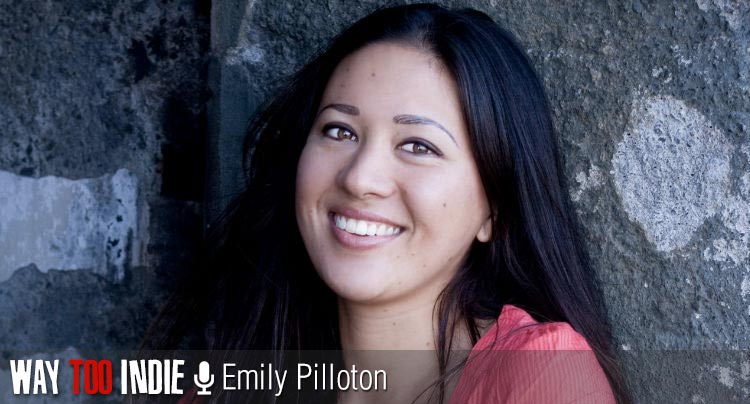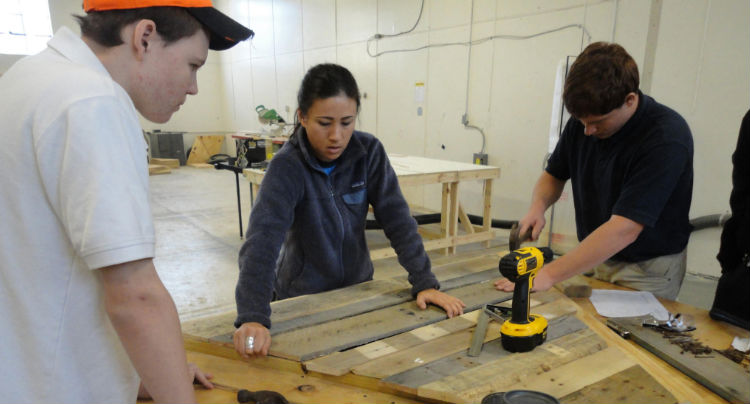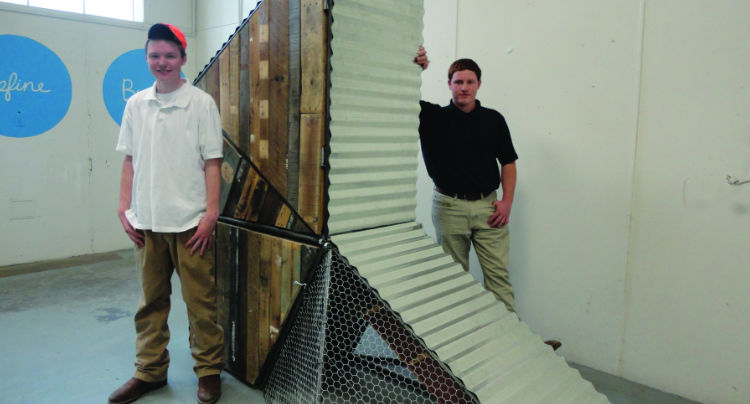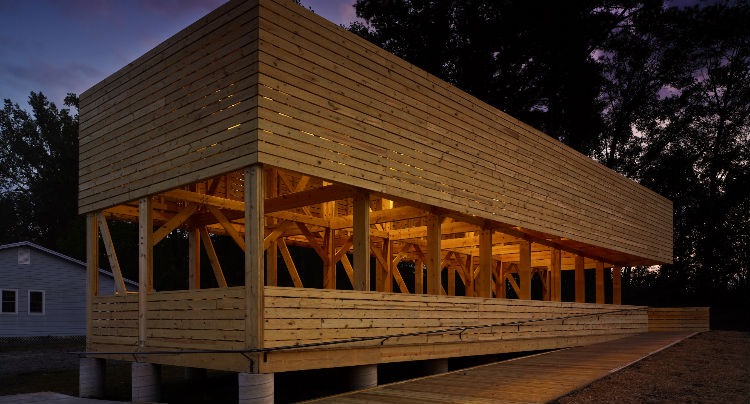Emily Pilloton Talks Inspiring Students Through Design in ‘If You Build It’

If You Build It, an uplifiting documentary directed by Patrick Creadon (I.O.U.S.A., Wordplay), follows designer-activists Emily Pilloton and Matthew Miller, who in 2010 moved to Bertie County, the poorest county in North Carolina, to set up Studio H, a forward-thinking shop class designed to help students learn to not just build “stuff”, but to build things that help enrich their community and their lives.
Pilloton and Miller taught the kids how to weld, draw up blueprints, and as a class project they even designed modern-looking chicken coops. The biggest class project, however, was to build a structure to house the town farmer’s market, an endeavor that would push everyone–including Pilloton and Miller–to their limits. The entire school year was captured by Creadon and his crew, and though the experience was fraught with obstacles and high emotions at times (Pilloton and Miller were forced to give up their salaries by the school board, which wasn’t receptive at all to their innovative curriculum), it ultimately instilled in the students a sense of accomplishment, ingenuity, and ambition, and gave the town a beautiful structure (now called the Windsor Super Market) that would boost its floundering economy.
Studio H is now in its fourth year, with Pilloton implementing the program at REALM Charter School in Berkeley, California. She sat with us in San Francisco to talk about the first time she built something, why she chose to move to Bertie, engineering Studio H, how other educators have received her unorthodox teaching methods, and more.
If You Build It opens February 28 in Landmark Theaters in San Francisco and Berkeley, and will have a one-day screening at the Christopher B. Smith Rafael Film Center in San Rafael, which Pilloton will be attending in-person for a Q&A.

Do you remember the first time you built something?
Emily: I grew up on Mt. Tamalpais, so my parents’ backyard was the forest. My youngest sister and I would go out into the forest and build random stuff. I remember having an intense relationship with the natural world. We had tree houses and forts and all that good stuff, but we also had this room which was like this rec room/game room/storage unit. It was this hodgepodge of a room. We had this one toy in there called “Quadro”, which I don’t know if they make anymore, but it was this building set with red tubes and black elbow joints. It was pretty big–each of the tube pieces were 14 inches long. You could build anything! It was all right angles, and so you’d build these cubes and then build others that grew off of it, and there were these squares you could snap on top. That was basically my whole childhood, building structures out of this Quadro set. Legos never did it for me.
Why not?
Emily: They were too tiny. Didn’t like Micro Machines either. Give me the big bricks! (laughs) But, playing with Quadro was one of my first creative memories. Another memory is, on Sundays, we’d go to church, and then I’d go to open houses with my dad and critique the architecture of these homes. Then, I’d come home and draw floor plans of my bedroom and rearrange all of my furniture. (laughs) I guess the mix of all of those things meant I was destined to go to architecture school.
And you went to Berkeley.
Emily: It was okay. It was a great primer as to what architecture was. I remember at the orientation for that program, the dean at the time, Mike Martin said, “Only 15 percent of you are going to become architects. This program is about a visual understanding of how to see the world.” In that way, it was exactly that. But I left Berkeley feeling that it was really theoretical, and I wanted to build stuff. So I went to the Art Institute of Chicago, which at the time had zero curriculum and 100,000 square feet of shop space. That was the best two years of my life.
What made you fall in love with Bertie County?
Emily: It was a love-hate relationship. (laughs)
What was it that made you choose to stay there? Because you and Matthew were flying back and forth for a while.
Emily: Yeah. We were back and forth between the Bay Area and Bertie County for about a year, and we did four big architectural projects with the superintendent there, Dr. Zullinger. He’s the one who invited us. It wasn’t so much that we fell in love with the place. We just had a better understanding of it and a better idea of what was possible. We built four playgrounds, three computer labs, a weight room for the football team, a county-wide graphic campaign. We felt that, if we’re going to talk about design in this place, this school district, it has to be in the classroom. It wasn’t so much falling in love. It was, “This is what we owe to these kids.”
Matt and I were coming to this place with really big ideas and a different skill set that didn’t exist there. We got to know some of the kids. They’d ask, “What’s architecture school like?” or, “Can you teach me how to weld?” We realized, yeah, we can teach you all of those things. And we should. If we’re really going to make an impact here, we have to be in the classroom with kids.

Like you say in the movie, Bertie County is a “rural ghetto” where the most brilliant kids always leave to move on to better things. Talk about this “brain drain”.
Emily: Sitting here in the Bay Area and trying to imagine what the rural South is like, your brain goes to all of the stereotypes. “It’s poor. It’s black. It’s a food desert.” All of those things are sort of true, statistically, but it’s also a really beautiful, small-scale place. There are its saddest stories, but on the flip-side there’s also something beautiful, quaint, and intimate about a town like that. The whole county is less than 20,000 people, only 25 people per square mile. It’s kind of stuck in this rut of historical baggage. I think the impacts of hundreds of years of slavery and institutionalized racism is very much still alive and kicking.
You experienced this?
Emily: Oh my god! I’d go to the post office and up having a conversation about slavery at 10 in the morning on a Tuesday. I’d have these “Where am I?” moments. You realize that the entire county needs a therapy session. There are a lot of things that have never really healed, and that comes out in different ways.
There definitely is a “brain drain”. There’s a guy, Ron Wesson, who you see in the film and is actually now the county commissioner. He talks a lot about how, the first thing kids that do well in school and get into any college want to do is get on the first train out of there and never, ever come back. Why would they? Part of our charge was to create those reasons for these kids to come back and to take pride in this place that they call their hometown.
What was the process like of creating the curriculum for Studio H?
Emily: We had ideas as to how things were going to turn out, but then we’d start doing it, realize it was all wrong, and throw it out the window. We’re in the fourth year of teaching the Studio H program, and we’ve definitely gotten better at writing a course map for where we’re going, but the way we get there is totally unpredictable. Because of the nature of the work, we were going to build a piece of civic, public architecture for the town. There were so many variables. Would the mayor give us this plot of land or this plot of land? Would the town council give us x, y, and z? Would a tornado come and destroy 7 houses and kill 14 people? (Which it did.) There were all these moving parts. In a normal classroom, you can control pretty much everything. In a class like ours, where we’re building something for the town, with changing conditions and all kinds of constraints, pretty much nothing could be scripted. The best thing we could do was to be adaptable and listen to what our kids were telling us. They were the ones who suggested we build a farmer’s market.

So that was their idea.
Emily: Yeah, totally. As soon as they said that, we were like, okay, now we know what the “thing” is.
Is that scary?
Emily: Not anymore. A part of my job now is doing professional development for other teachers, and that’s the biggest, scariest thing for them: letting go of control. Like, it’s August, you have to get to June, and most teachers will say, “By June, my students will know these 16 standards.” We’ve never had that approach. We’re like, “It’s August. We’re going to build something by June, and we have no idea what it’s going to look like, but it’s going to be really fun.” That’s a very different mindset for teachers to take, but for students, they think it’s great, because they have a voice. If they want to build a floating island in the middle of the bay, it’s like, “Great! Here are your tools!”
Did you build an island in the bay with your students?
Emily: No. (laughs) That was just the craziest thing I could think of. We have an 8th grade class right now, and they don’t have a school library.
The school in Berkeley?
Emily: Yeah. It’s a charter school in their third year called REALM. A lot of these kids are English language learners, and some of them left another school district because it just wasn’t working for them. Our 8th graders said, “We’re the first graduating class, and we don’t have a school library. Can we build it?” We said, “Yes! That’s the coolest thing ever!” So that’s their project. If we had scripted a curriculum, maybe they wouldn’t have had the audacity to say that.
You’re instilling this audacity in them.
Emily: Yeah. I want our students to feel like our classroom is a place where they can say the craziest possible thing, and we’ll take them seriously.
I love how malleable your program is. Have you spoken to other educators about your methods, and have they been receptive?
Emily: Yes and no. I think a lot of what we do runs counter to what almost every teaching certification program teaches. In other words, the way that most teachers are trained is totally opposite of what our classroom looks like, in good ways and bad ways. I’d say we’re horrible at classroom management. You walk into our class, and it’s really loud. But I swear to god they’re being productive! It just doesn’t feel like a normal classroom. There are a lot of educators that are now saying, “This isn’t working.” There’s something to creativity, to messiness, to letting kids be kids. Kids are already brilliant, and we’re the ones stifling them. So, how do we break down that foundation to allow them to be these creative people?
You see design thinking in more schools now, and I think that’s a really good start. But I also really want to see schools shooting for the moon. Like, “We want to build a floating island in the bay!” I think there’s this constant, “Well, we can’t do that because x, y, and z.” That’s one of the most broken things about school systems, this defeatist attitude. “Everything’s broken, so all we can do is tweak around the edges.” Someone needs to just blow up the core and start all over.
When the Bertie school board cut most of your funding and you chose to give up your salary, was that a difficult choice to make?
Emily: No. It was never a thought. I kind of love thinking back on this, because it just gets me really riled up. Dr. Zullinger was hired to fix that school district. He started doing these audacious things, but in doing so ruffled a lot of feathers. We were one of his pet projects. The school board ran him out of town. The other thing is that, the school board is one of the only political strongholds that the African American community holds tightly. Almost all of the other municipal positions are held by older white men. It becomes this weird “civic vs. school board” thing. But, the school board cut everything Dr. Zullinger ever touched. When they said that they were tearing up our contracts, they really expected us to leave, but we said, “Fine.” We were sort of playing chicken for a minute, but it was never a debate. We didn’t think of leaving once. We had our students. The school board thought we were in it for the money. Screw them.
The camera crew wasn’t there every day to film you guys, but were there bad days where you just didn’t want them around?
Emily: That was the hardest year of my entire life. First of all, I’m a half Asian woman from California living in the deep South. That sucked. There was this deep moment of reflection where I was like, “I am all of these things. I’m living in this place. Here’s what I can control, and how am I going to make the most out of these moments with these kids? Everyone else can bite me.” I was training for a marathon at the time, and I had stuff thrown at me. It was crazy stuff. But we also had neighbors that would bake us stuff every day. It was this weird polarity.
One day, one of my students called me a useless bitch, kind of jokingly. I didn’t know what to do. I just started crying, got in my car and went home. It was my first time teaching, as well. Everyone in Studio H was out of their comfort zone, and that’s what I think is beautiful about the film. We were all really uncomfortable a lot of the time. On days where I’d be really confused, I’d communicate it to my students. I think that kind of vulnerability created a really wonderful sense that we were in it together.
Do you still talk to them?
Emily: Oh yeah. I talked to one of them just the other day. They’re nightmares and the most amazing human beings at the same time. The thing I love most about them is that they were so underestimated by everyone, and then they blew them all away. They’re like local heroes now. My one student, Eric, emailed me recently and said, “I was in the grocery store and this woman came up to me and said she recognized me.” He told her that he worked on the farmer’s market, and she said “Bless you!”
